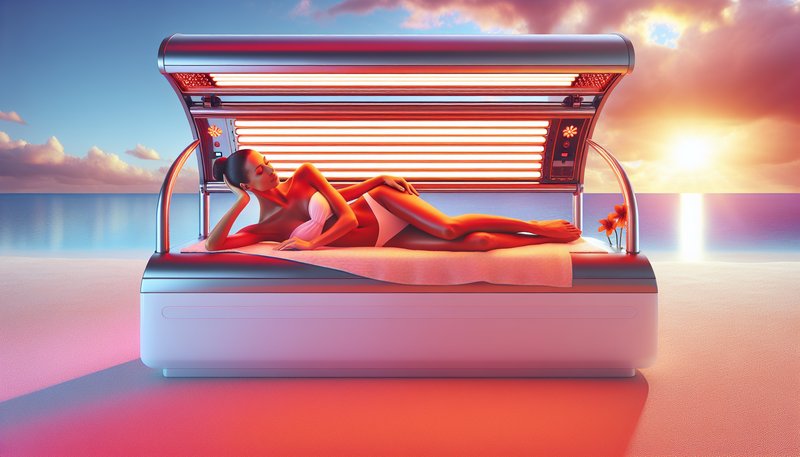What Is Red Light Therapy Tanning?
Have you ever wondered about a tanning method that claims to provide benefits beyond just skin color?
Red light therapy tanning is an innovative approach that merges the benefits of red light therapy with traditional tanning. This article will explore its definition, benefits, considerations, alternatives, and address common questions surrounding this intriguing treatment.
Key Takeaways
- Red light therapy tanning uses specific wavelengths of red light to enhance skin health and promote tanning.
- It offers additional benefits, such as improved skin texture and possibly reduced inflammation.
- Considerations and alternatives are important when deciding if this method is right for you.
What is Red Light Therapy Tanning?
Red light therapy tanning is a treatment that harnesses specific wavelengths of light, usually between 600 to 650 nanometers, to stimulate cells in the skin. This method is distinct from traditional tanning, which primarily involves UV radiation that penetrates the skin to promote melanin production.
The practice typically takes place in specialized devices that emit red light. These devices may be full-body beds or handheld units, allowing users to expose their skin to the red light while laying down or standing.
One of the key aspects of red light therapy tanning is its dual purpose: it serves both as a method to achieve a sun-kissed glow and as a therapeutic treatment that may improve skin conditions, aiding in overall skin health.
What are the Benefits of Red Light Therapy Tanning?
Exploring the benefits of red light therapy tanning reveals several compelling advantages that may appeal to individuals seeking to enhance their appearance and well-being.
Skin Health Improvement
Red light therapy is known to improve skin health by promoting collagen production. Collagen is vital for maintaining skin elasticity and reducing the appearance of fine lines. Regular exposure to red light can lead to smoother, healthier-looking skin over time.
Reduced Inflammation
Another benefit is its ability to potentially reduce inflammation. Conditions such as acne or eczema may see improvement when treated with red light therapy, as the light helps to calm inflammation and promote healing.
Enhanced Mood and Energy Levels
Beyond skin benefits, red light therapy tanning may also contribute to improved mood and energy levels. Some users report feeling rejuvenated and more energetic after sessions, likely due to enhanced cellular function and circulation.
Potential Anti-Aging Effects
The anti-aging effects of red light therapy tanning can be significant, as it encourages cellular turnover and rejuvenation. This treatment can provide a more youthful appearance without the risks associated with excessive UV exposure.
Is it Possible to Achieve a Tan with Red Light Therapy?
Achieving a tan with red light therapy is indeed possible, although it differs from traditional tanning techniques. Unlike UV tanning, red light tanning does not primarily rely on melanin production but rather on the enhancement of skin health and potentially stimulates melanin to a lesser degree.
What are the Advantages of Achieving a Tan this Way?
The advantages of red light therapy tanning include:
- Safer Skin Exposure: Unlike UV rays, red light does not cause sunburn or damage to skin cells, making it a safer alternative for those concerned about skin health.
- Dual Benefits: Users can enjoy both cosmetic enhancement and therapeutic effects, leading to healthier skin.
- Customizable Sessions: Red light therapy sessions can be tailored to individual skin types and goals, allowing for a more personalized experience.
What are the Disadvantages of Achieving a Tan this Way?
While red light therapy tanning has its advantages, it also comes with drawbacks:
- Gradual Results: Unlike traditional tanning, which can provide immediate results, red light tanning often requires multiple sessions over time to achieve the desired tan.
- Limited Melanin Production: It may not achieve the deep tan that UV tanning offers, which could be a consideration for those wanting a darker skin tone.
- Equipment Costs: Access to the necessary devices can be limited, and purchasing or visiting facilities offering these treatments can be more costly compared to standard tanning beds.
What are the Things to Consider Before Trying Red Light Therapy Tanning?
Before deciding on red light therapy tanning, there are several crucial factors to take into account.
Skin Type and Sensitivity
Understanding your skin type is vital, as some individuals may be more sensitive to light therapies. Consulting with a dermatologist can help determine if this treatment aligns with your skin’s needs.
Commitment to Sessions
Achieving optimal results often requires a commitment to regular sessions. Be prepared for a potentially longer timeline to reach your desired skin color and health benefits.
Quality of Equipment
The effectiveness of red light therapy tanning can vary significantly depending on the quality of the equipment used. Researching studios or facilities that use reputable brands and technologies is essential for achieving the best results.
What are the Alternatives to Red Light Therapy Tanning?
If red light therapy tanning does not align with your preferences, there are several alternatives worth exploring.
Traditional UV Tanning
Traditional tanning involves the use of UV rays to darken the skin. While it can provide quick results, it comes with risks of skin damage and increased cancer risk.
Self-Tanning Products
Self-tanning lotions, sprays, and mousses offer a safe way to achieve a bronzed look without UV exposure. These products typically use dihydroxyacetone (DHA) to temporarily darken the skin.
Bronzing Beds
Bronzing beds use modified UV light to provide a tan while attempting to minimize damage. They operate similar to traditional tanning beds but with a focus on producing less harmful rays.
Spray Tans
Spray tanning provides an instant tan through an aerosol application. The results are immediate and customizable, though they typically wash off after a week or so.
Conclusion: Is it Recommended to Try Red Light Therapy Tanning?
In summary, red light therapy tanning offers a unique and promising alternative for those interested in enhancing their skin’s appearance and health. It presents an opportunity to combine both therapeutic and cosmetic benefits, although it may require patience and commitment. Weighing the benefits against the potential drawbacks, individuals looking for a safer tanning method may find red light therapy tanning a worthwhile option to explore.
See the complete post Can Red Light Therapy Cause Cancer?
Frequently Asked Questions
What is the difference between red light therapy and traditional tanning?
Red light therapy primarily uses wavelengths of light that do not promote UV damage, while traditional tanning exposes the skin to UV rays to increase melanin production.
How often should I undergo red light therapy tanning?
Frequency will depend on your skin type and desired outcome, but many recommend starting with two to three sessions per week for optimal benefits.
Can red light therapy tanning replace sun exposure completely?
While it can provide a safer alternative to UV tanning, it may not replicate a deep tan achieved through sun exposure. Many consider it a supplement rather than a complete replacement.
See the complete post Can Red Light Therapy Worsen Melasma?
Is red light therapy suitable for everyone?
While generally safe, individuals with certain skin conditions or sensitivities should consult a dermatologist before starting red light therapy tanning.






